How to make authentic Cacio e Pepe with just 4 simple ingredients! This classic Roman pasta has a creamy, cheesy black pepper sauce that comes together in 10 minutes. Quick, flavorful, and perfect for a weeknight dinner or an easy Italian-inspired meal.
If you like this recipe, then you’ll love my Authentic Carbonara, and Lemon Ricotta Pasta, all simple, cozy Italian dishes made with just a few ingredients.
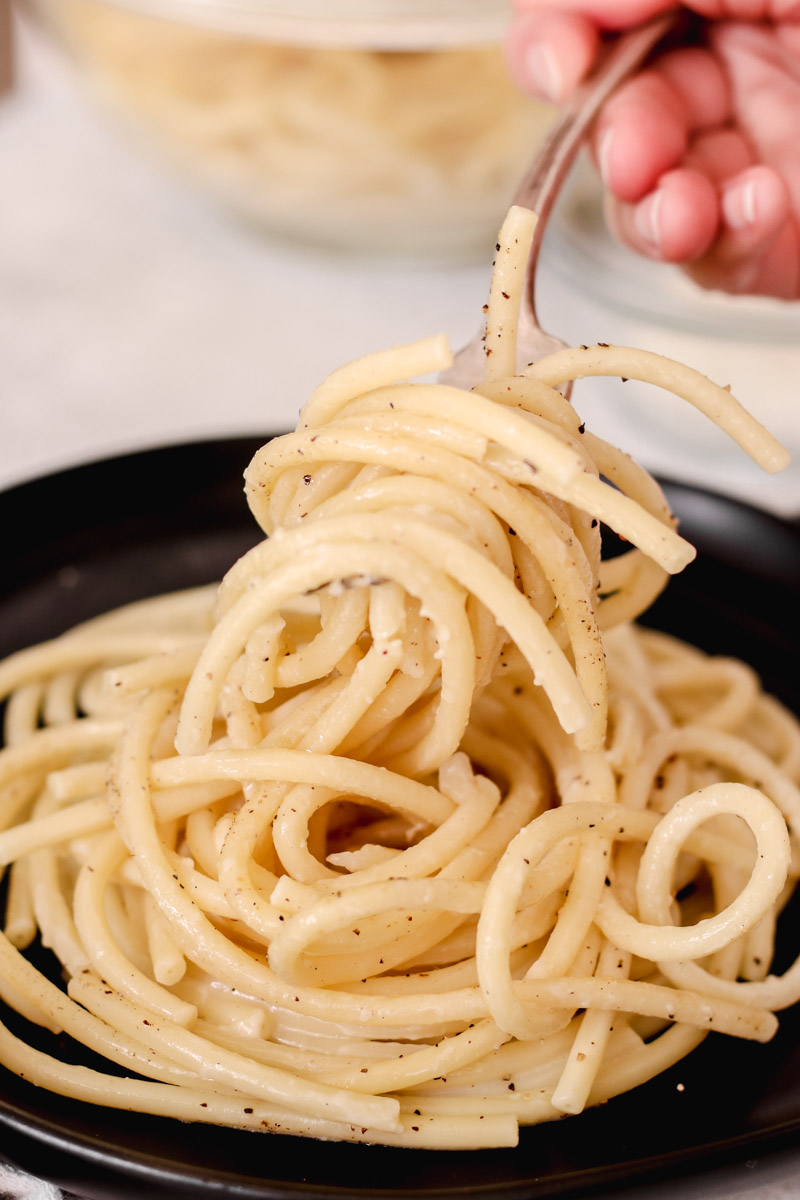
This article contains affiliate links which supports us at no extra cost to you.
Jump to:
So dreamy and indulgent, this authentic cacio e pepe recipe is one I never get tired of making. The salty and sharp flavor of Pecorino Romano cheese blends perfectly with the starchy pasta water to create a silky, creamy sauce that coats every strand of pasta. With each bite of this classic Roman pasta, the heat of the black pepper shines through, and it truly feels like magic on a plate.
Whenever I am craving comfort food, my mind always goes straight to this Italian pasta recipe from Rome. Cacio e pepe comes from the Lazio region, and out of all the Italian recipes I grew up with, it is one of my family’s absolute favorites. We make it at least once a month, and my husband always asks for it when we want something simple but unforgettable for dinner.
Cacio e pepe is also one of the four traditional Roman pasta recipes, along with spaghetti alla carbonara, pasta amatriciana, and pasta alla gricia. Each one is iconic, and I will be sharing them all here soon, starting with this incredible cacio e pepe pasta that shows just how amazing a dish can be with only four ingredients.
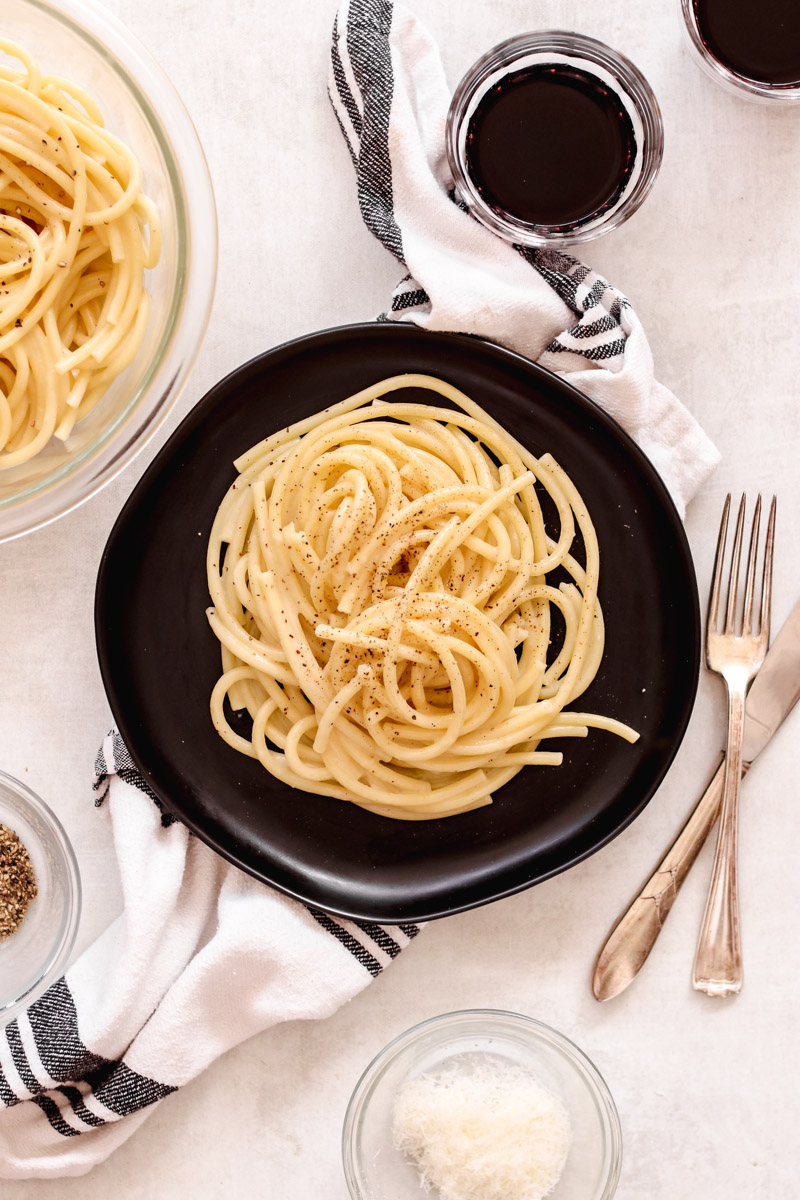
Like the spaghetti carbonara, this is one of the recipes that we always have the ingredients on hand for. Bucatini (or spaghetti), black pepper, and the cheese. Yes, we always have what it takes to make this!
Simple and basic, it just takes a little practice to get the right sauce. In a matter of minutes, your lovely shredded cheese could turn thick and clumpy. And once it’s clumped, you can’t get it silky smooth again (wasted cheese is very sad).
What ingredients are in cacio e pepe?
Here is all you need to make this classic Roman pasta dish (full printable recipe is below):
- Pasta: Bucatini, thick spaghetti, or tonnarelli are the traditional cacio e pepe pasta shapes. Bronze cut pasta will work best as the rougher edges help the sauce to stick to the pasta. These are the traditional shapes, but you could use whatever pasta shape you have on hand and it will still be delicious!
- Pecorino Romano: An aged sheep's cheese that is the traditional cheese in this classic Roman pasta. It has a more earthy and salty flavor than Parmigiano-Reggiano. But you will find recipes in Italy where they use even a blend of both cheeses. If you only have Parmigiano on hand, go ahead and use that. But be sure to grate your own cheese so it won't clump up.
- Butter: As it is with many Italian recipes, there will be different methods. I've made the sauce with and without butter, many, many times. I like the flavor with a bit of butter. You could leave out the butter and just use more starchy water. It's completely up to you. No judgement, it's your pasta!
- Black pepper: Freshly ground pepper is essential for this pasta recipe. It will have a richer flavor. Pre-ground will not have the same flavor impact. You could finely or coarsely grind the pepper. I like a lot of pepper in my cacio e pepe, but you could use less if you do not enjoy it or are sensitive to black pepper.
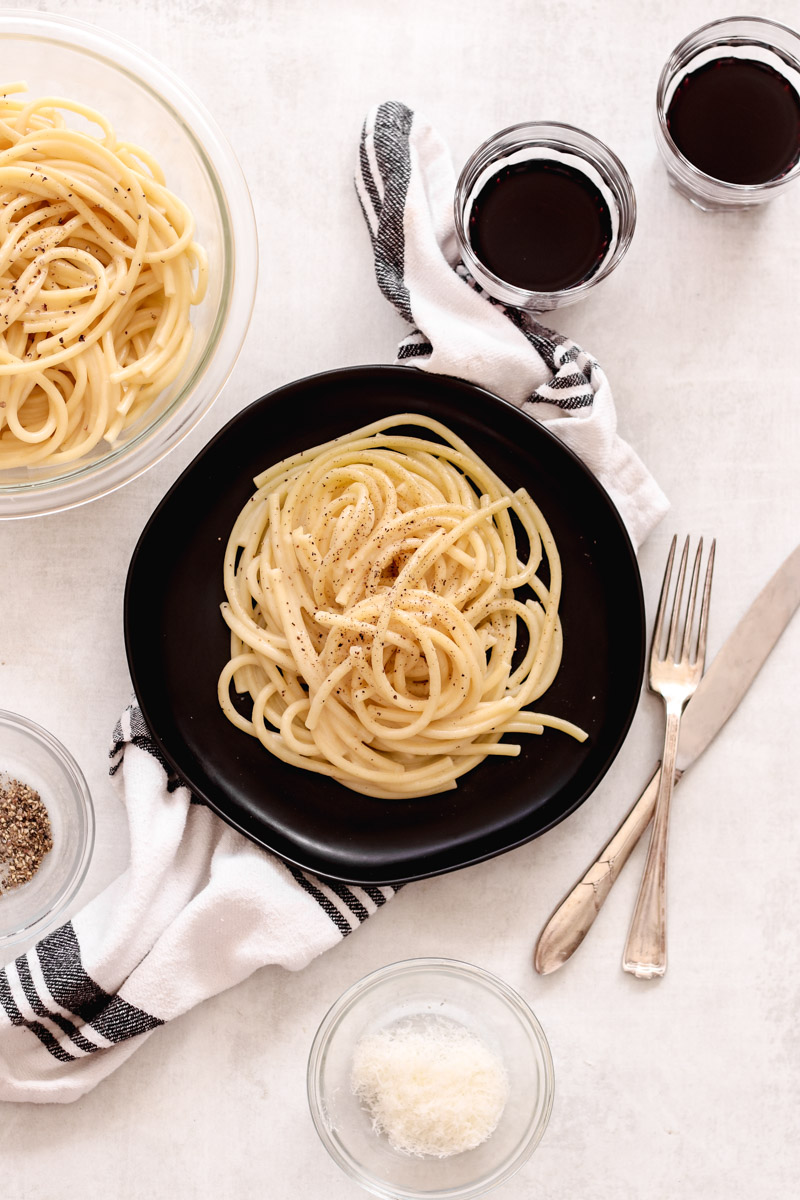
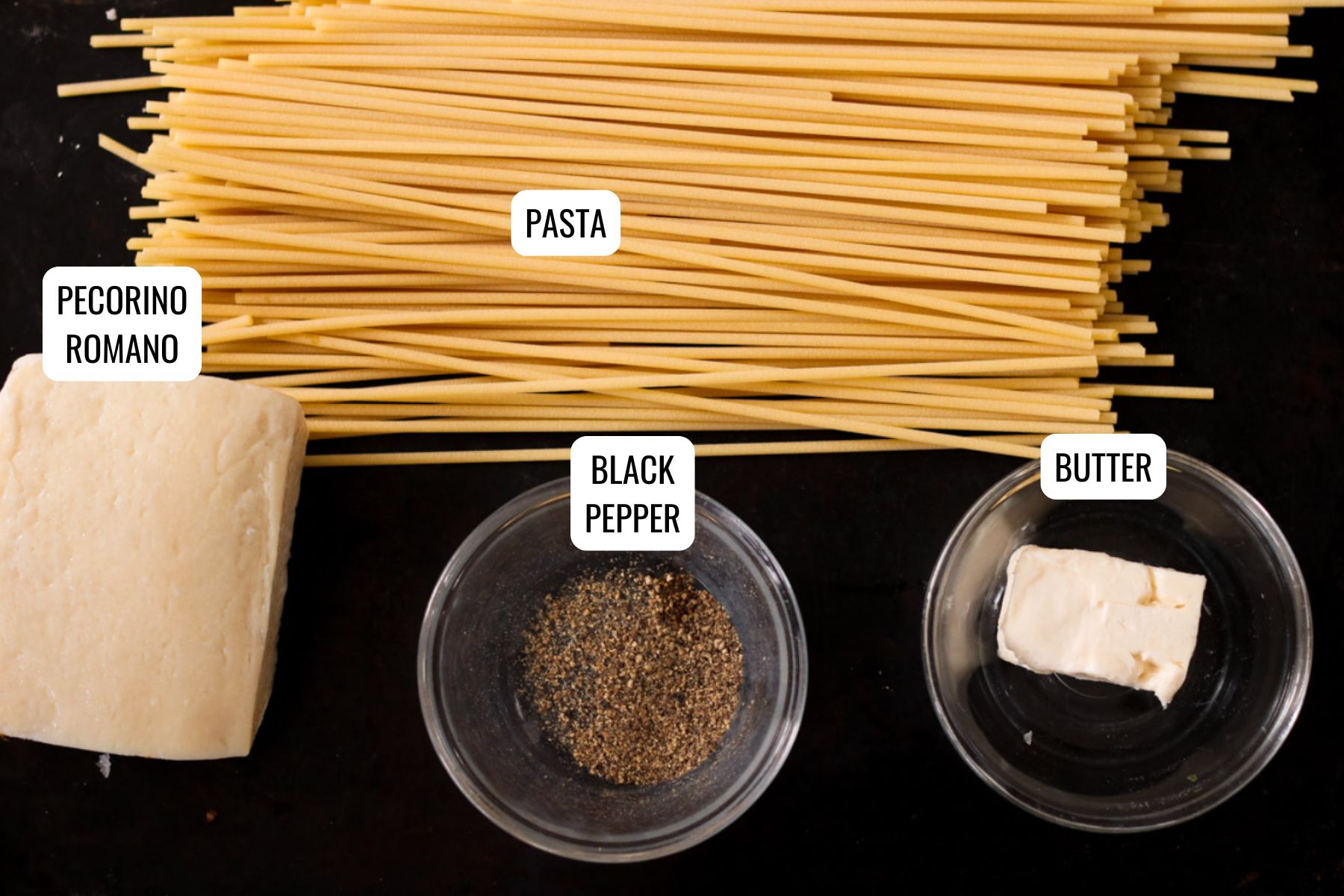
How to make an easy cacio e pepe
Step 1: First step is to always gather up all your ingredients. The fancy term for that is mise en place. Since this is a very fast recipe, with everything ready in it's place, you'll be ahead of the game!
Fill a large pot with water and add just a teaspoon of salt (the sauce will be salty from all the grated cheese!). When the water comes to a rolling boil, add in your pasta.
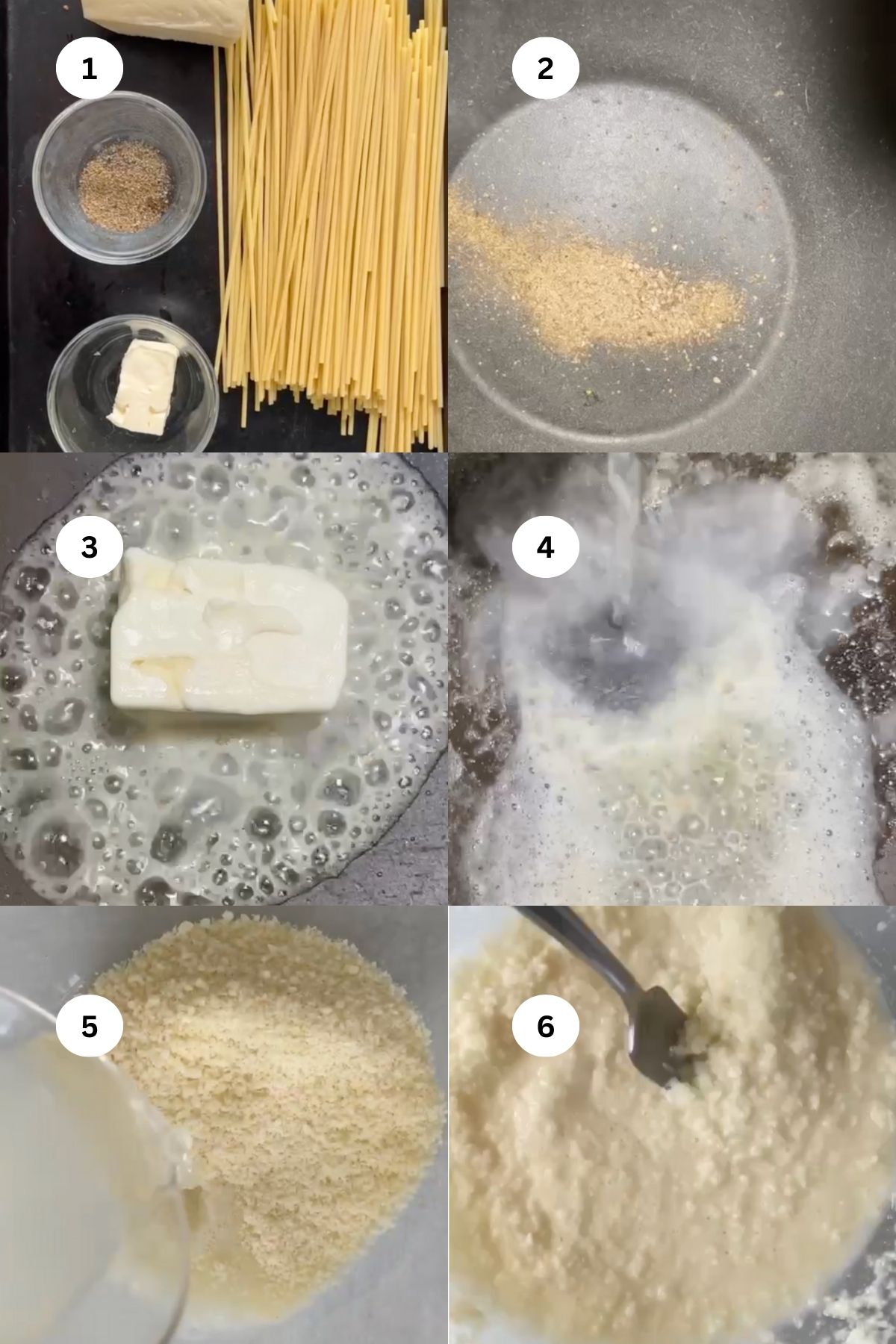
Set your timer for the pasta (according to your pasta directions on the box). Set it for 2 minutes under the cook time. While the pasta cooks, move onto the sauce preparation.
Step 2: Heat the freshly ground black pepper to toast it. This takes just seconds on medium heat. IF you heat the pepper more, you will not be able to breath from the pepper fumes (I have done this).
Step 3: IF you are using butter, add that now to pan. Melt the butter on medium-high heat. When the butter melts, remove the pan from the heat.
Step 4: Ladle in some starchy pasta water
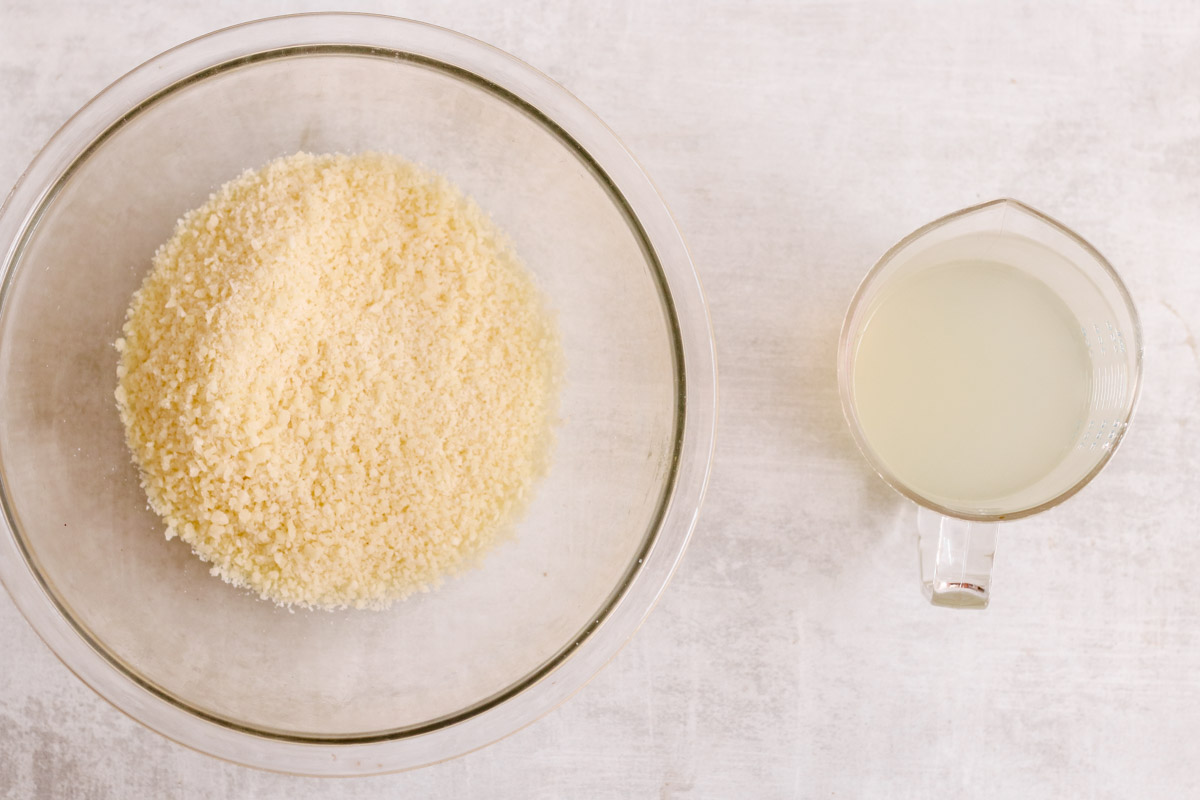
Step 5: In a bowl, add the grated cheese and 1 cup of the pasta water.
Step 6: Stir it together to make a cheesey paste.
I like to ladle out another portion of the starchy water into the cup (like about ⅓ of a cup). You may not end up using all the starchy pasta water, but better to have extra on hand. Careful getting out the water, it's boiling hot.
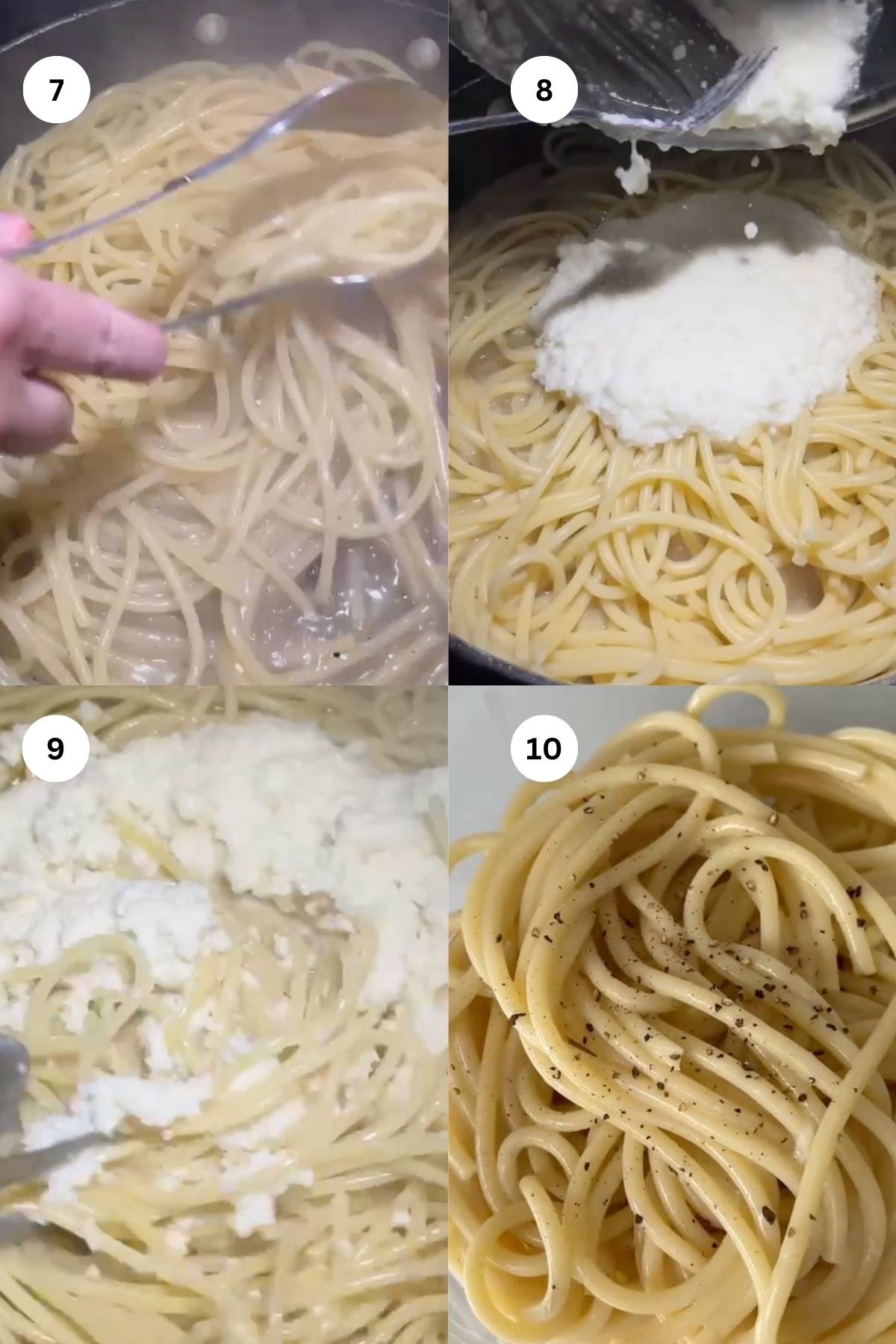
Step 7: Drain the pasta in a colander, and immediately add it to the pan with the butter and pepper.
Step 8: Add the cheese mixture and toss with tongs to combine.
Step 9: Add in some more of the starchy pasta water to thin out the sauce, as needed. Just start with a tablespoon at a time and toss. When the sauce is glossy coating the pasta and creamy, it is ready to enjoy!
Step 10: Transfer your cacio e pepe to a serving dish and fresh cracked black pepper and some more grated Pecorino, if you want.
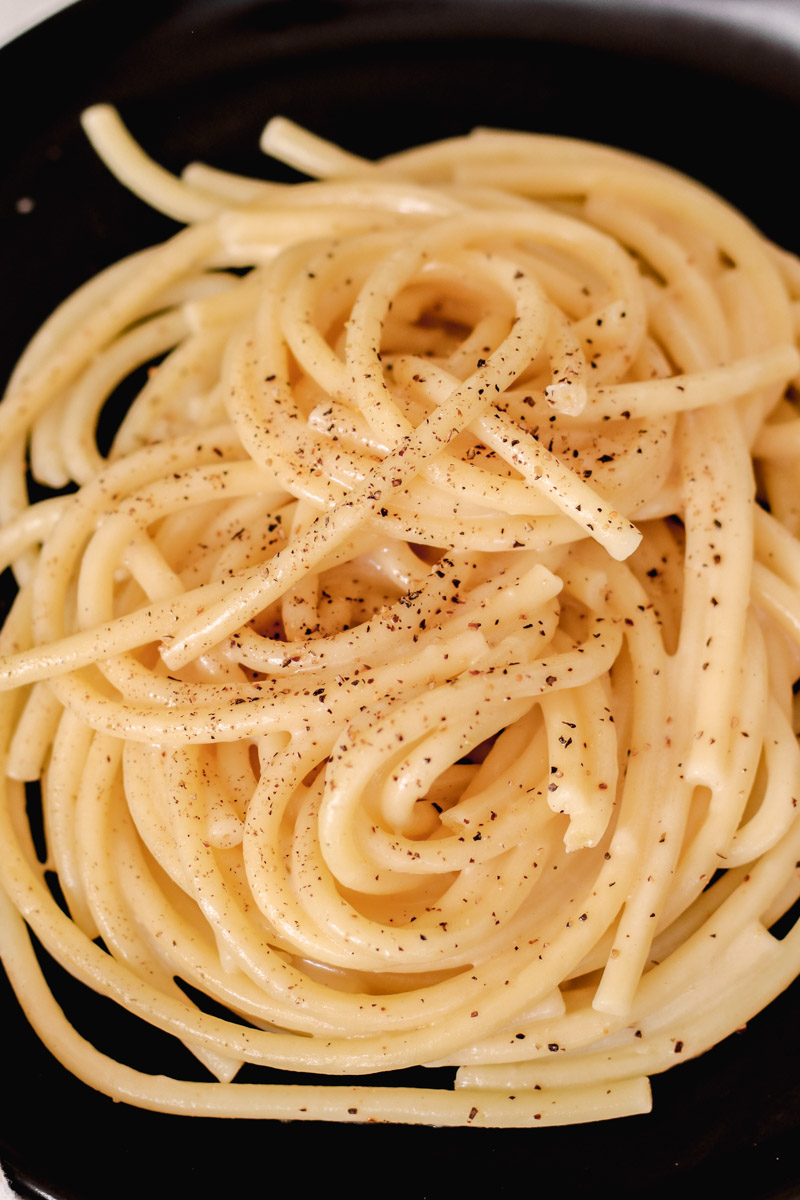
FAQ's
Typically it is bucatini or spaghetti. If you can get your hands on tonnarelli, use that. I've seen it also made with short pastas.
Cacio e pepe is a pasta dish that is generous with black pepper. If serving for kids, cut back on the amount.
You should coarsely grind enough black pepper to get a full 1 tablespoon.
Yes, go ahead and use your favorite gluten-free pasta brand.
You have to taste the pasta to know if it's al dente. Carefully remove a strand of pasta using a slotted spoon. Best to quickly rinse it in cold water and take a bite. Otherwise, you'll burn your tongue.
Yes, cacio and pepe pasta is completely vegetarian. It has dairy so it is not vegan.
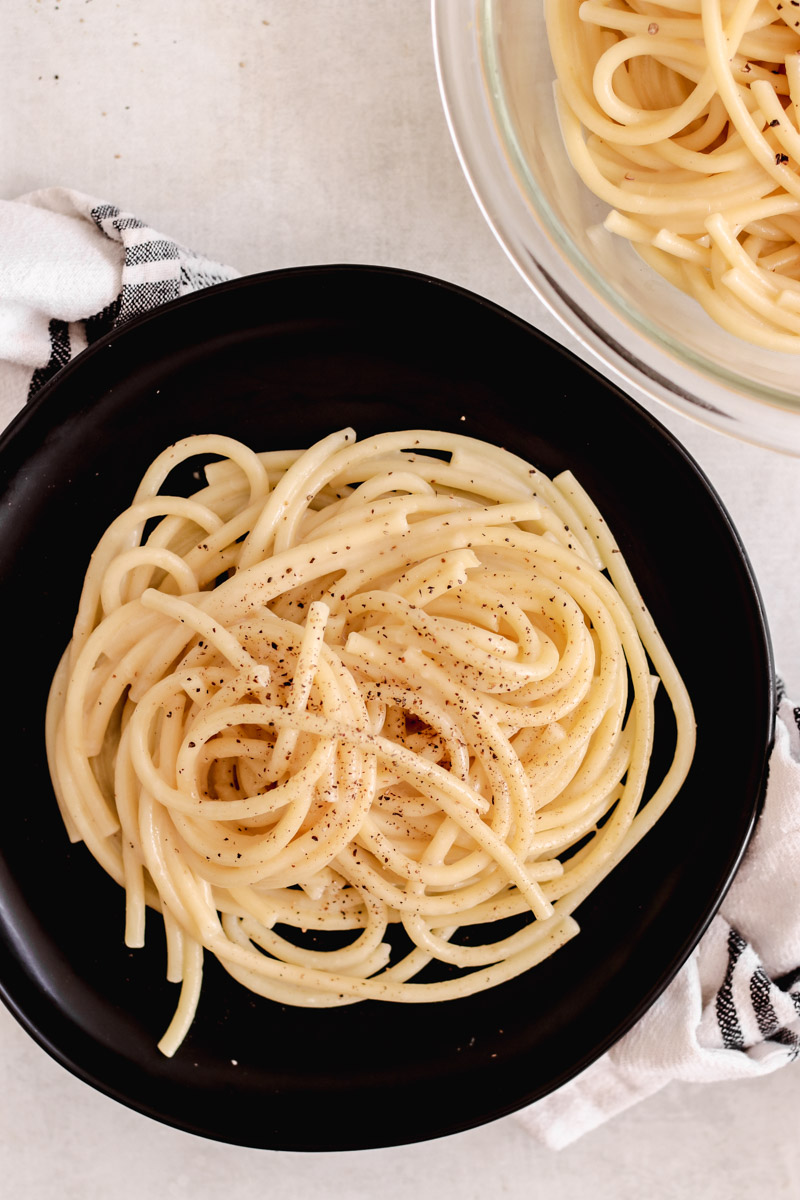
How to get the creamy sauce?
It is a simple but sort of finicky technique that gets the creamy cacio e pepe sauce. There is NO heavy cream or milk involved. It is the combination of very starchy pasta water with the Pecorino Romano.
Why does cacio e pepe sauce get clumpy?
Some reasons why it could get clumpy:
- Using the wrong cheese. Be sure to use a real Pecorino Romano. If you can find a DOP, that would be best.
- Don't use cold water. Some people may think to add some cold water to the sauce, and that will just make it clump up terribly.
- Grate cheese fine. Be sure to grate the cheese very finely. Too thick and it will be harder to melt.
Tips for making cacio e pepe
- Only freshly grated cheese will work. Pre-grated cheeses have an anti-clumping coating (which will make it difficult to melt with the pasta water).
- Grate cheese with the smallest grater hole. When you grate the cheese on your grater, use the smallest hole. If you grate it thicker, it will take a bit more to melt.
- Essential to use freshly cracked pepper. The flavor won't be as intense with pre-ground pepper. Pre-ground pepper is oxidized (exposed to oxygen)and doesn't taste as rich as freshly ground black pepper.
- Boil the pasta with less water. Using less water to boil the pasta will result in a more starchy pasta water. The starch in the pasta water is what helps to make your creamy sauce. Reserve more pasta water in case it thickens a bit too much to loosen the sauce.
- Mushy pasta will ruin this dish. It's so important to keep an eye on the pasta and make sure it does not get overcooked. In Italy, the pasta is ALWAYS al dente (to the tooth with a firm bite). Cook a minute or two under. Since it will be combined with the starchy water in the pan and will cook a little bit more.
- Have your equipment ready to go. It's best to find your colander and have it ready in the sink and also the tongs that you will use to toss the pasta with the cheese sauce.
- Be sure to use a large sauté pan. It's important to make the sauce in a large pan and to have enough room to add your pasta and combine it together.
- Just keep stirring. With the pan off the heat, stir and stir to combine the pasta with the starchy water and Pecorino mixture. At first it may seem as if it's clumping, but keep stirring and add a bit more of the starchy water if it needs to loosen. Keep combining and coating the pasta until it is creamy and not watery.
- Don't let the cacio e pepe pasta sit too long. Cacio e pepe is a dish that is made quickly and should be enjoyed as soon as it's made. It's best not to leave it sitting long while you prep other things. Enjoy the first bite as soon as it's ready and hot!
How to store leftovers
- To Store: Store any leftovers in an airtight container in the refrigerator for up to three days.
- To Freeze: I do not recommend freezing this pasta dish.
Reheating Leftovers
Typically we finish off all the pasta and it is best enjoyed freshly cooked up. IF in case you to have any portion leftover, you could reheat it in a pan. Add a splash of water to help the sauce loosen up as it's heating up in medium-low. Grate on some more cheese, if you like.
What to serve with cacio e pepe
Cacio e pepe is a classic Italian dish that pairs perfectly with a variety of dishes. To complete the meal, try adding an antipasti platter featuring cured meats and cheeses, a mediterranean salad, and freshly baked focaccia or crusty bread.
Some other pasta recipes to enjoy:
Did you make this and love it? Please RATE THE RECIPE below:)
I would LOVE IT if you could leave me a star rating and a review down below and let me know your thoughts! It means the world to me to hear how you liked it.
Please Subscribe and give a follow on Instagram, Facebook, Pinterest, and TikTok xx
📖 Recipe
Easy Cacio e Pepe (With Black Pepper and Pecorino Romano)
Ingredients
- 1 pound of pasta I use bucatini but you could use spaghetti
- sea salt for the pasta water
- 1 ½ teaspoons freshly ground black pepper
- 2 ½ cups Pecorino Romano finely grated
- 3 Tablespoons butter optional
Instructions
- Boil the pasta water: Bring a large pot of salted water to boil (just add 2 teaspoons of salt) water to a boil. Use less water to cook the pasta than you normally would, so the water will be more starchy. Cook the pasta, stirring occasionally.
- Grate the cheese: Finely grate the Pecorino Romano and add it to a bowl. Add in a cup of the starchy water from the boiling pasta to the cheese. Stir together to make a paste and set aside.
- Toast the black pepper: In a large pan, add the freshly ground pepper on medium heat. Toast it for just a few seconds (make sure to toss the pepper while it's toasting. It will burn quickly and the fumes are awful).
- Add the butter and some starchy water: If using the butter, now is the time to add it to the pan and melt it combining it with the pepper. Ladle in ½ cup of the pasta water and bring it to a simmer while the pasta is cooking. Turn off the heat.
- Drain the pasta: Cook the pasta until it's just before al dente (about 1-2 minutes before it's ready). Drain the pasta, reserving some more of the pasta water (about ½ cup should be fine).
- Combine with the cheese: Add the Pecorino mixture immediately to the pan with the pasta and use tongs to combine . Stir it continuously until a smooth and creamy cheese sauce is created. Keep stirring until it will turn into a smooth and creamy sauce. The sauce should cling to the pasta and be glossy and not thin. If it's too thick, add another tablespoon of the pasta water and stir.
- Serve pasta: Plate up the pasta as soon as it's ready. Grind on some more black pepper and a dusting of Pecorino, if you like. This pasta is extra delicious served hot. Enjoy immediately!
Nutrition Disclaimer
Please keep in mind that the nutritional information presented below is an approximation and may vary depending on the exact ingredients used.
Notes
- Only freshly grated cheese will work. Pre-grated cheeses have an anti-clumping coating (which will make it difficult to melt with the pasta water).
- Grate cheese with the smallest grater hole. When you grate the cheese on your grater, use the smallest hole. If you grate it thicker, it will take a bit more to melt.
- Essential to use freshly cracked pepper. The flavor won't be as intense with pre-ground pepper. Pre-ground pepper is oxidized (exposed to oxygen)and doesn't taste as rich as freshly ground black pepper.
- Boil the pasta with less water. Using less water to boil the pasta will result in a more starchy pasta water. The starch in the pasta water is what helps to make your creamy sauce. Reserve more pasta water in case it thickens a bit too much to loosen the sauce.

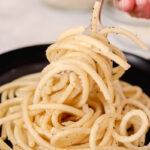
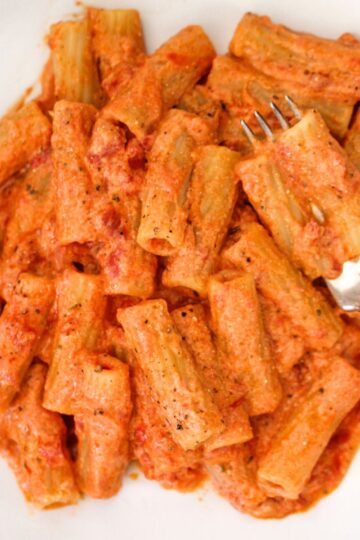
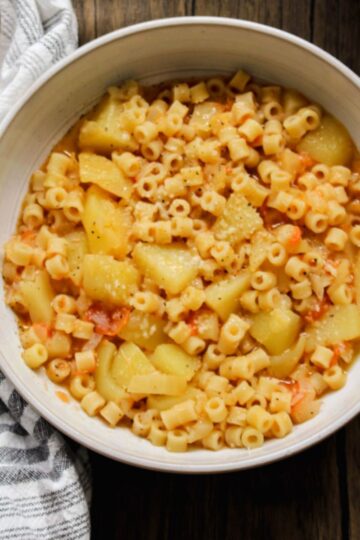
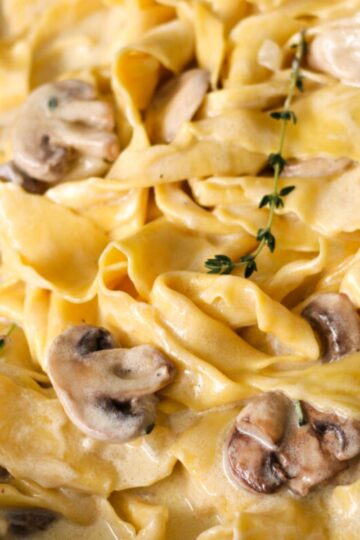

Comments
No Comments